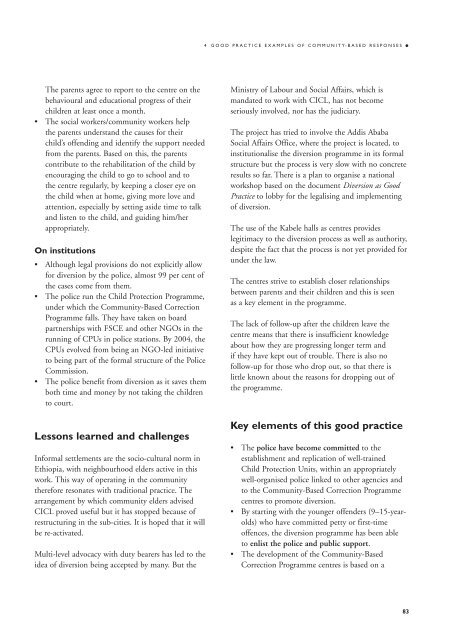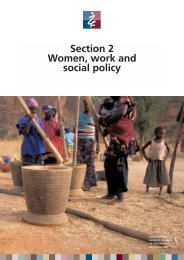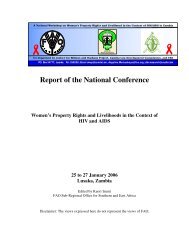The Right Not to Lose Hope - Violence Against Children - East Asia ...
The Right Not to Lose Hope - Violence Against Children - East Asia ...
The Right Not to Lose Hope - Violence Against Children - East Asia ...
- No tags were found...
You also want an ePaper? Increase the reach of your titles
YUMPU automatically turns print PDFs into web optimized ePapers that Google loves.
4 GOOD PRACTICE EXAMPLES OF COMMUNITY-BASED RESPONSES ●<strong>The</strong> parents agree <strong>to</strong> report <strong>to</strong> the centre on thebehavioural and educational progress of theirchildren at least once a month.• <strong>The</strong> social workers/community workers helpthe parents understand the causes for theirchild’s offending and identify the support neededfrom the parents. Based on this, the parentscontribute <strong>to</strong> the rehabilitation of the child byencouraging the child <strong>to</strong> go <strong>to</strong> school and <strong>to</strong>the centre regularly, by keeping a closer eye onthe child when at home, giving more love andattention, especially by setting aside time <strong>to</strong> talkand listen <strong>to</strong> the child, and guiding him/herappropriately.On institutions• Although legal provisions do not explicitly allowfor diversion by the police, almost 99 per cent ofthe cases come from them.• <strong>The</strong> police run the Child Protection Programme,under which the Community-Based CorrectionProgramme falls. <strong>The</strong>y have taken on boardpartnerships with FSCE and other NGOs in therunning of CPUs in police stations. By 2004, theCPUs evolved from being an NGO-led initiative<strong>to</strong> being part of the formal structure of the PoliceCommission.• <strong>The</strong> police benefit from diversion as it saves themboth time and money by not taking the children<strong>to</strong> court.Lessons learned and challengesInformal settlements are the socio-cultural norm inEthiopia, with neighbourhood elders active in thiswork. This way of operating in the communitytherefore resonates with traditional practice. <strong>The</strong>arrangement by which community elders advisedCICL proved useful but it has s<strong>to</strong>pped because ofrestructuring in the sub-cities. It is hoped that it willbe re-activated.Multi-level advocacy with duty bearers has led <strong>to</strong> theidea of diversion being accepted by many. But theMinistry of Labour and Social Affairs, which ismandated <strong>to</strong> work with CICL, has not becomeseriously involved, nor has the judiciary.<strong>The</strong> project has tried <strong>to</strong> involve the Addis AbabaSocial Affairs Office, where the project is located, <strong>to</strong>institutionalise the diversion programme in its formalstructure but the process is very slow with no concreteresults so far. <strong>The</strong>re is a plan <strong>to</strong> organise a nationalworkshop based on the document Diversion as GoodPractice <strong>to</strong> lobby for the legalising and implementingof diversion.<strong>The</strong> use of the Kabele halls as centres provideslegitimacy <strong>to</strong> the diversion process as well as authority,despite the fact that the process is not yet provided forunder the law.<strong>The</strong> centres strive <strong>to</strong> establish closer relationshipsbetween parents and their children and this is seenas a key element in the programme.<strong>The</strong> lack of follow-up after the children leave thecentre means that there is insufficient knowledgeabout how they are progressing longer term andif they have kept out of trouble. <strong>The</strong>re is also nofollow-up for those who drop out, so that there islittle known about the reasons for dropping out ofthe programme.Key elements of this good practice• <strong>The</strong> police have become committed <strong>to</strong> theestablishment and replication of well-trainedChild Protection Units, within an appropriatelywell-organised police linked <strong>to</strong> other agencies and<strong>to</strong> the Community-Based Correction Programmecentres <strong>to</strong> promote diversion.• By starting with the younger offenders (9–15-yearolds)who have committed petty or first-timeoffences, the diversion programme has been able<strong>to</strong> enlist the police and public support.• <strong>The</strong> development of the Community-BasedCorrection Programme centres is based on a83
















